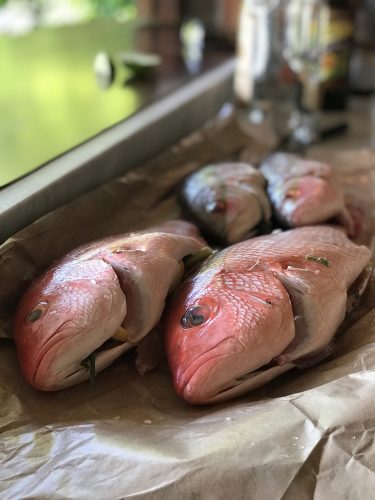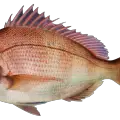Snapper nutrition is essential to a person’s diet, especially because it entails a very delicious, lean fish which helps to deliver a protein kick that is quite high. Snapper contains vitamin B and selenium.
The Nutritional Facts
• Serving size – 3 ounces
• 109 calories
• 1 gram of fat
• No fiber
• No sugar
• No monounsaturated
• No saturated
• 22 grams of protein
• 1 gram of fat
Vitamins and Minerals
Vitamin B6 – It comes in 0.4 mg with a 20% daily value.
Vitamin B12 – Comes in 3 mcg with 50% daily value.
Phosphorus – 171 mg with 17% daily value.
Selenium – Comes in 41.6 mcg with 59% daily value.
Potassium – It comes in 444 mg with 13% daily value.
Snapper Overview
Fun fact is that snapper is not a fish that you would want to have an encounter
with in the dark alley of the ocean. It has a metallic pink hue, with a
Mohawk-like dorsal fin, and rows of needle teeth which are quite sharp, which
gives it an intimidating look. However, meeting snapper on a plate is what most
people prefer dressed in some fresh herbs and lemon. The snapper family
consists of many different types. The one that is referred to as “Snapper” in
the Americas is what’s called the red snapper. It comes from the Western
Atlantic Ocean and from the Gulf of Mexico. In the Gulf ecosystem, they are a
top predator. They feast on the small fish, thanks to their sharp pointy teeth.
In the 80s, the depletion of snapper was getting low, but thanks to good
management from the fishing industry, it is making a huge comeback currently.
Snapper, being a meaty fish, it has lean white flesh that has moist in it, as
well as a texture that is essentially firm. Like most white fish, it has a mild
and slightly sweet flavor.
Best Ways to Select Snapper
When it comes to snapper selection, you need to shop at a store with a good overall
selection of fish. This will enable you to get the best quality fish. Buy fish
from a good fish monger who can give you detailed information about the fish
you are buying. They should tell you the kind of species it is, the date and
place of fishing, as well as how to prepare and even store it. You can find snapper,
in a fresh state, or as frozen fillets. Fresh fillets are supposed to look
moist and it normally has a rosy tinge. However, it shouldn’t be wet with any
muscle fibers separation in between. It is highly recommended that you choose
skin-on fillets because skin-off fillets might not be the genuine red snapper
which you might assume. A red snapper should also have a distinctive rosy hue
skin. Here are some of the things you need to look for when you are purchasing
a whole fish;
• Shiny scales
• Deep red fins
• Red gills that are clean
• Clear glassy eyes
• Pinkish-silver bellies
A fresh snapper is also supposed to be displayed over ice and if possible, you
should sniff the fish. It is supposed to have an oceanic smell that is
pleasant. If the smell happens to be bad trust your nose and look elsewhere.
Snapper Storage
When it comes to snapper nutrition, you must consider proper storage. The
storage period depends on when the fish was caught. However, if you wrap the
fish well in plastic and then store it over ice, it can last for about 5 days
in the fridge from when it was caught. It is normally recommended to eat it in
a day if you are not aware when it was caught. The benefit of snapper is that
you can be frozen. You freeze it by wrapping it up well and storing it for
about 2 months. The reason why you need to wrap it up well is to avoid freezer
burn. A snapper that has been cooked can be stored in the fridge for about 5-6
days, but also for 2 months in the freezer.












